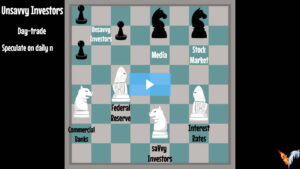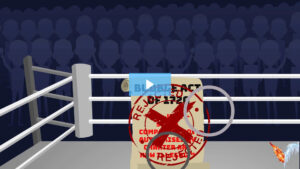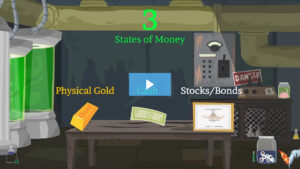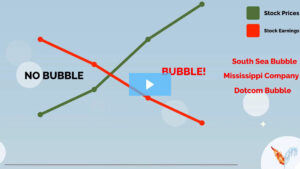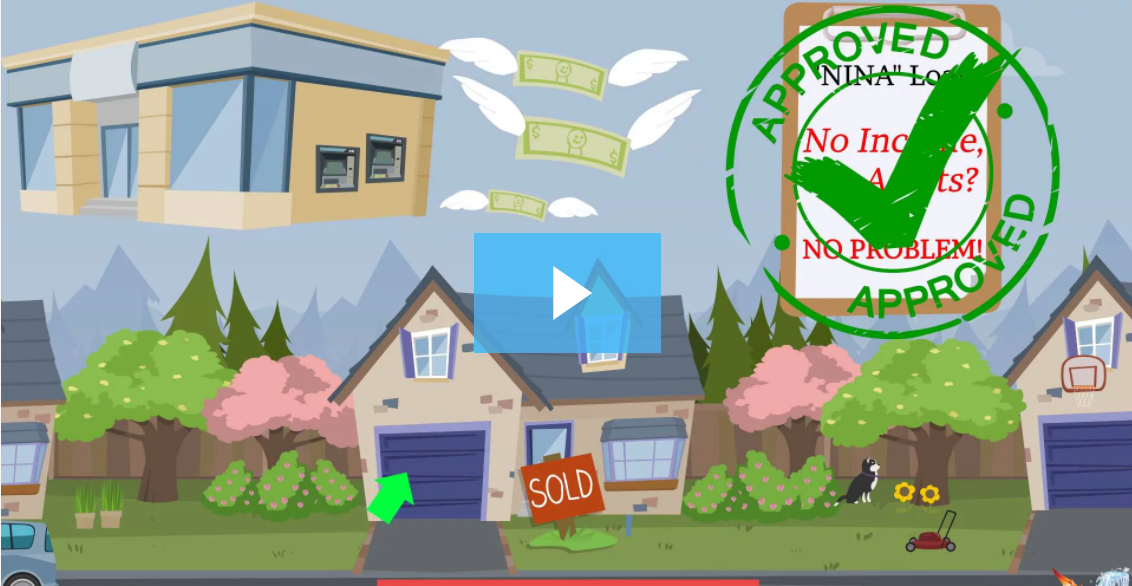
Following the dotcom bubble burst, the US housing market was the next sector investors would bid up prices past their true values. The US housing market bust would be one of the most devastating crashes since the Great Depression. The roots of the mortgage meltdown were put in place 80 years before the meltdown transpired. The Federal National Mortgage Association (Fannie Mae) is an entity that was created as part of FDR’s New Deal. Fannie Mae is a government-sponsored entity, supported by the federal government, however, remains an independent and publicly-traded corporation since 1968. Its purpose is to purchase mortgages from banks, bundle them into tradeable securities, and sell those securities to investors in public markets. This would allow for banks to have immediate cash rather than having to wait 30 years to receive it from the borrower. Fannie’s brother “Freddie Mac” (Federal Home Loan Mortgage Corporation) was created in 1970 to purchase Fannie’s securities on the public market, package the securities, and sell the packages as mortgage-backed securities. The final product was called a “collateralized debt obligation” (CDO). The foundation for the largest real estate speculative fever in US history was firmly in place.
In 1992, a directive was issued by the federal government that ordered Fannie and Freddie to dedicate a specific percentage of mortgage purchases to affordable housing. The goal was to help low-income individuals and families have easier access to affordable housing. The Department of Housing and Urban Development (HUD) was in charge of dictating the percentage that would be allocated to affordable housing mortgage purchases. At the start of the policy, the HUD dedicated 30% to affordable housing, then 40% in 1995, 42% the next year, 50% by 2000, and 58% by 2008. Fannie and Freddie held $5 trillion of low-income housing commitments. On September 30, 1999, the New York Times reported that “Fannie was facing increasing pressure from the Clinton Administration to expand mortgage loans to low and moderate income people as stockholders began pressuring management to maintain its share price growth. As a result, banks and mortgage companies have encouraging Fannie Mae to help make loans to “subprime borrowers.”
A subprime borrower has a low likelihood of paying back the principal and interest on a loan. Because the risk to a lender is greater when loaning to a subprime borrower, the lender will charge higher than the prime rate. Fannie and Freddie found it increasingly difficult to find borrowers that had a relatively decent credit level but still qualified as low-income. As a result, the standards of loaning to subprime borrowers relaxed from the late 1990s into early 2000s. In 1994, the subprime market was relatively small only accounting for $35 billion of new mortgage originations. However, the swell would increase over the next 12 years as $35 billion grew to $600 billion in newly issued home mortgages. As lending standards relaxed, new features were added to loans. Some loans required proof of income or assets, while a “NINA” loan did not require proof of either. An example of a reckless lending practice was a bank in California approving a $754,000 mortgage to a first time home-buyer making only $17,000 a year. First-time borrowers were tasked with having to understand terms such as “interest-only negative-amortizing adjustable-rate subprime mortgage.” Simply put, these new features lowered the lending standards low enough by making the ability to pay off the loan in its entirety nearly impossible. By 2004, almost 50% of mortgages in San Diego were interest-only loans, meaning not one cent of principal was being paid off. Despite the dip in the economy due to the Dotcom bubble pop in 2000, the world’s oil-producing countries were still doing very well. However, as interest rates began dropping in early 2000, those countries began seeking an investment that would provide a relatively stable return with a high level of safety. As the swelling of subprime mortgages continued, investment banks conjured up an idea to satisfy the needs of those overseas investors. The solution was to create a form of insurance, called a credit default swap (CDS) that would shift the credit risk from the investor to the insurer. This tossed the subprime risk to the opposite party by buying insurance on the subprime security. Large insurer, AIG, had a derivatives department that was dedicated to selling credit default swaps. The fee AIG charged was as low as 0.12 of 1%, not reflecting the true underlying risk the insurer was really taking on. As the rate of homeownership rapidly increased to almost 70% by 2006, the percentage of subprime mortgages increased as well to 20%, up from 7% just 3 years ago. Rating agencies such as Moody’s and S&P were put in charge of rating CDOs. However, conflicts arose as the fees paid to the rating agencies were from the companies that were creating the CDOs in the first place. As a result, some CDOs that included over 1,000 mortgages of varying credit ratings were assigned one credit rating. Ratings agencies relied heavily on rating CDOs as a source of revenue. In 2006, CDO ratings made up 44% of Moody’s revenue. The real estate bubble was beginning to inflate.
In spite of conventional wisdom, a single-family home is an expense-heavy burden rather than a savvy investment. Adjusted for inflation, home prices increased 0.4% per year from 1890 to 2004. During most of the 1990s, most of investor’s capital was guided into dotcom stocks. The value of US home values did not move much during this time. From the beginning of 1990 to 1997, home prices moved up 8.3%, not subtracting inflation over the 7-year period. The price of real estate began to increase after 1997 as many incentives caused investors to flood into the real estate market. Tax incentives such as the deductibility of mortgage interest, tax-free capital gains of up to $250,000 for a single person and $500,000 for a married couple drove investors to real estate investing. As the Federal Reserve lowered interest rates to 1% by 2003, its lowest level in 45 years, the demand for real estate grew. The housing mania was running rampant in the “sand states,” such as California, Florida, Nevada, and Arizona. “Flipping” or buying rundown homes in hopes of fixing and selling for a profit became a popular way of trying to cash in on the real estate boom. Magazines, books, and TV personalities added further fuel to the speculative fever as everyday Americans were rolling up their sleeves to fix and flip their home. Headlines such as “Are You Missing the Real Estate Boom?” and “The Real Estate Boom Will Not Bust – And How You Can Profit from It” began to emerge. The cover of Time Magazine posted a cover story explaining why they were “Going Gaga Over Real Estate.” As people’s home values grew, the amount of home loans grew as well. In 2005, US homeowners borrowed $750 billion against their homes to pay for cars, boars, electronics, or invest in the stock market. The signs the real estate market reached its peak became evident. Bubble denial became a feeling as the National Association of Realtors (NAR) attempted to tamper down talks of a bubble. The NAR began distributing “Anti-Bubble Reports” in August 2005 that stated, “there is virtually no risk of a national housing price bubble based on the fundamental demand for housing and predictable economic factors.” A few months later, President George Bush asserted that “if houses get too expensive, people will stop buying them.”
Once the economy began to pick-up after the dotcom bubble and 9/11, the Federal Reserve decided to raise interest rates from its 45-year low of 1%. The Federal Reserve lifted the “Fed rate” from 1% to 5.25% in 17 installments between 2004 and 2006. Subprime borrowers that had a “lock” on interest rates when they were low would no longer be locked in at a low rate. Borrowers became exposed to higher payments as a result of the increase in interest rates. Despite the stock market still rising, the S&P/Case-Shiller Home Price Index recorded its first year-over-year decline in home prices in the first quarter of 2007, the first time in 16 years. Borrowers started to default, and foreclosures began to rise. The situation started to worsen by March 2007 when over 25 subprime lenders went bankrupt or reported severe financial distress. On April 2, 2007, the largest subprime lender in the US, New Century Financial, declared bankruptcy with over $100 million in liabilities. This would be the beginning of bankruptcies as in August 2007, American Home Mortgage filed for bankruptcy. Merrill Lynch posted a $7.9 billion loss on CDOs. Bear Stearns also added to the bad news reporting a $1.2 billion loss from mortgage-backed securities in November 2007. Despite the Federal Reserve cutting interest rates from 6.25% to 4.75% in a few months, most of the damage had already been done. By the end of 2007, foreclosures were up 75% from 2006, which had doubled already from the year before.
2008 marked the year the stock market would feel the economic shock from the housing market. Bear Stearns investment bank became the center of attention as it started to face serious risks due to the subprime meltdown. On March 14th, 2008, a $25 billion loan was injected by the Federal Reserve Bank of New York to stabilize Bear Stearns. However, the Federal Reserve withdrew the loan, increased the amount to $30 billion, and issued the loan to JP Morgan with an agreement to buy Bear Stearns for $2 per share. The announcement was a shock to Wall Street. Bear Stearns share price traded at $172 per share in 2007, and just weeks before the announcement was still trading at $93. Shareholders became outraged as the price collapsed upon the news to $15 and filed a lawsuit. The Federal Reserve and JP Morgan increased the offer to $10 per share. This meager increase still resulted in a 94% drop from its peak a year earlier. An 85 year-old giant was left to fail when it was believed the giant investment banks were deemed “too big to fail.” Lehman Brothers was the next investment bank to go bankrupt. The Korean Development Bank sparked a minor interest in buying Lehman Brothers but would not attract other investors. As a result of the news announcement, Lehman’s shares tanked 45%. Before the stock market opened on September 15th, 2008, Lehman Brothers announced it would be filing for bankruptcy, ending the bank’s 158 year track record of being in business. Lehman’s bankruptcy meant $400 billion of CDS contracts were now at a total loss. AIG was next in line at bankruptcy court as the insurer failed to insure $441 billion of CDOs. The day after the Lehman bankruptcy announcement, AIG announced a liquidity crisis. The federal government assembled an $85 billion credit package to bailout AIG, one of the largest government bailouts in history. The panic was so great that investors began selling stock and moving their money to cash, or money market funds immediately. Almost $144.5 billion in money market withdrawals took place in a single week, almost 20x greater than the week prior. Custodians of money market accounts were redeeming slightly less than the full dollar value of the account due to the mad dash to cash. The Trouble Asset Relief Program or “TARP” packaged was proposed by Treasury Secretary Hank Paulson and Fed Chairman Ben Bernanke on September 18, 2008. Rumors of a $700 billion relief program made the stock market rally, however the selloff in stocks continued. From October 1, 2008 through October 9, 2008, the S&P 500 lost 22% of its already declining price. TARP was passed on October 3rd, 2008 but the bad news continued to pour in, and the stock market continued its collapse. By the end of 2008, 1/3 of the top 30 mortgage lenders went bankrupt and 5 of the largest investment banks either went bankrupt or were acquired. Real estate prices suffered a 25% decline from the peak of their values just two years before. By March 2008, over 10% of homeowners had negative equity in their homes, meaning they owed more on the house than what it was worth. By September 2010, 23% of US homes had a value lower than the mortgage amount. The Dow Jones fell 55% from its peak of 14,198.10 on October 9, 2007 to its bottom of 6,469.95 on March 6, 2009. To volatility, no asset is safe, even real estate.



